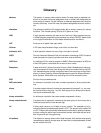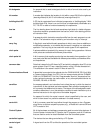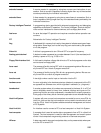
Glossary
542
differentiated instruction An instruction that is executed only once each time its execution condition goes
from OFF to ON. Non-differentiated instructions are executed each cycle as long
as the execution condition stays ON.
differentiation instruction An instruction used to ensure that the operand bit is never turned ON for more
than one cycle after the execution condition goes either from OFF to ON for a
Differentiate Up instruction or from ON to OFF for a Differentiate Down instruc-
tion.
digit A unit of storage in memory that consists of four bits.
digit designator An operand that is used to designate the digit or digits of a word to be used by an
instruction.
distributed control An automation concept in which control of each portion of an automated system
is located near the devices actually being controlled, i.e., control is decentralized
and ‘distributed’ over the system. Distributed control is one of the fundamental
concepts of PC Systems.
DM area A data area used to hold only word data. Words in the DM area cannot be ac-
cessed bit by bit.
download The process of transferring a program or data from a higher-level computer to a
lower-level computer or PC.
electrical noise Random variations of one or more electrical characteristics such as voltage, cur-
rent, and data, which might interfere with the normal operation of a device.
EM area Extended data memory area. Like DM, the EM memory can be accessed in word
units only and EM area data is retained when the power to the PC is turned off.
error code A numeric code generated to indicate that an error exists, and something about
the nature of the error. Some error codes are generated by the system; others
are defined in the program by the operator.
exclusive OR A logic operation whereby the result is true if one, and only one, of the premises
is true. In ladder-diagram programming the premises are usually the ON/OFF
states of bits, or the logical combination of such states, called execution condi-
tions.
exclusive NOR A logic operation whereby the result is true if both of the premises are true or both
of the premises are false. In ladder-diagram programming the premises are usu-
ally the ON/OFF states of bits, or the logical combination of such states, called
execution conditions.
execution condition The ON or OFF status under which an instruction is executed. The execution
condition is determined by the logical combination of conditions on the same
instruction line and up to the instruction currently being executed.
execution time The time required for the CPU Unit to execute either an individual instruction or
an entire program.
Expansion I/O Backplane A Backplane which is used to create an Expansion I/O Rack.
Expansion I/O Rack Part of a building-block PC, an Expansion I/O Rack is connected to either a CPU
Rack or another Expansion I/O Rack to increase the number of slots available
for mounting Units.


















